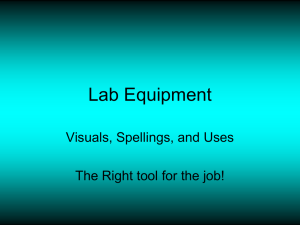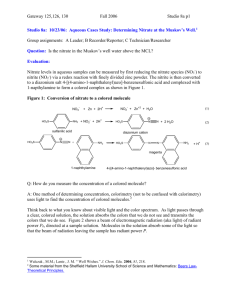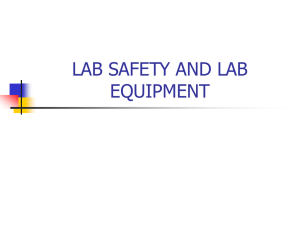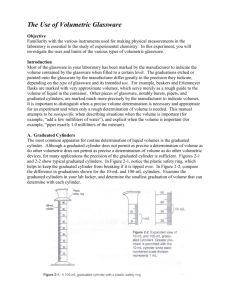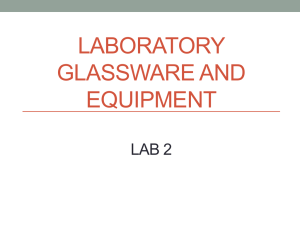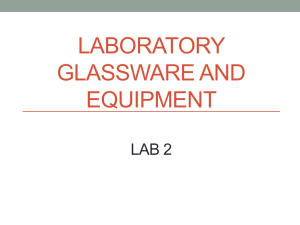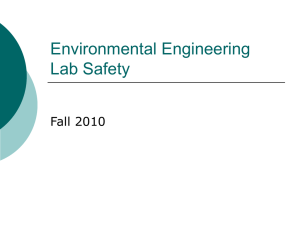Laboratory Techniques
advertisement
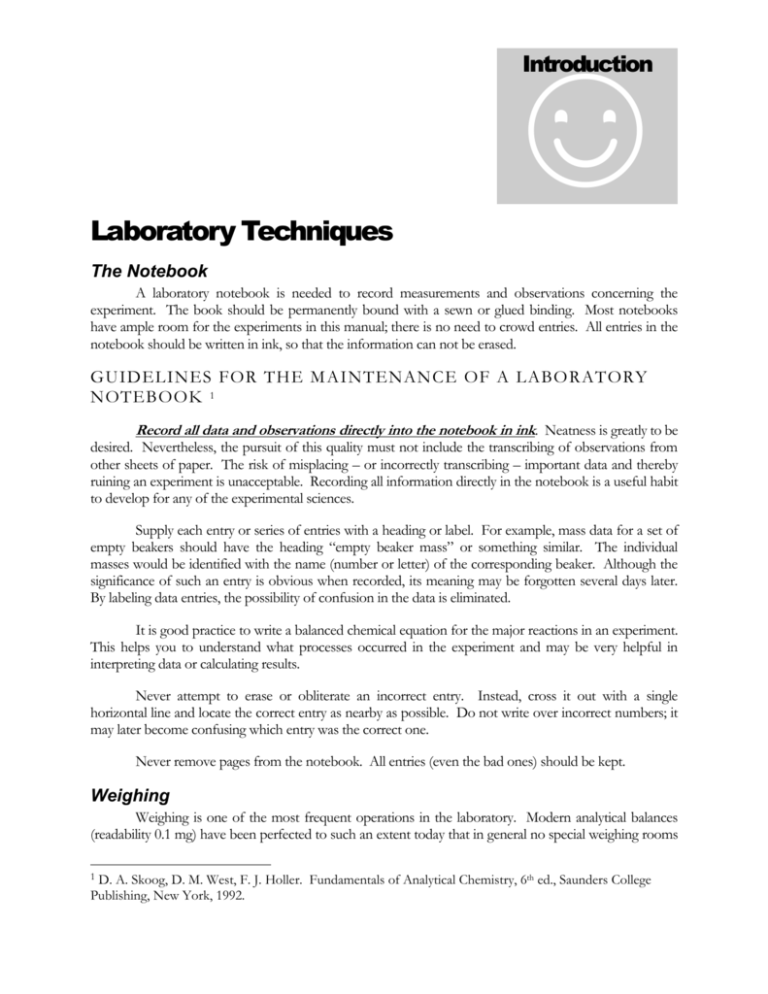
☺ Introduction Laboratory Techniques The Notebook A laboratory notebook is needed to record measurements and observations concerning the experiment. The book should be permanently bound with a sewn or glued binding. Most notebooks have ample room for the experiments in this manual; there is no need to crowd entries. All entries in the notebook should be written in ink, so that the information can not be erased. GUIDELINES FOR THE M AINTENANCE OF A LABO RATORY NOTEBOOK 1 Record all data and observations directly into the notebook in ink. Neatness is greatly to be desired. Nevertheless, the pursuit of this quality must not include the transcribing of observations from other sheets of paper. The risk of misplacing – or incorrectly transcribing – important data and thereby ruining an experiment is unacceptable. Recording all information directly in the notebook is a useful habit to develop for any of the experimental sciences. Supply each entry or series of entries with a heading or label. For example, mass data for a set of empty beakers should have the heading “empty beaker mass” or something similar. The individual masses would be identified with the name (number or letter) of the corresponding beaker. Although the significance of such an entry is obvious when recorded, its meaning may be forgotten several days later. By labeling data entries, the possibility of confusion in the data is eliminated. It is good practice to write a balanced chemical equation for the major reactions in an experiment. This helps you to understand what processes occurred in the experiment and may be very helpful in interpreting data or calculating results. Never attempt to erase or obliterate an incorrect entry. Instead, cross it out with a single horizontal line and locate the correct entry as nearby as possible. Do not write over incorrect numbers; it may later become confusing which entry was the correct one. Never remove pages from the notebook. All entries (even the bad ones) should be kept. Weighing Weighing is one of the most frequent operations in the laboratory. Modern analytical balances (readability 0.1 mg) have been perfected to such an extent today that in general no special weighing rooms 1 D. A. Skoog, D. M. West, F. J. Holler. Fundamentals of Analytical Chemistry, 6th ed., Saunders College Publishing, New York, 1992. are needed. Technological progress in electronics has allowed considerable simplification of the operation, drastic shortening of the weighing times, and the balances to be made so adaptable that today they can be integrated directly into the laboratory. However, this progress is associated with the danger that too little attention is paid to disturbing influences which affect the measured mass. These mostly concern physical effects that are measurable for analytical balances and can not be suppressed by them since actual mass changes are involved (e. g., slow evaporation or moisture gain), or forces that act on the weighing sample and the weighing pan (e. g. magnetism and electrostatic charge) and are also recognized by the balance as mass changes. With the information described here, the aim is to indicate the most important points that must be noted when working with analytical balances if weighing results of high quality are to be achieved. OPERATION Analytical balances are measuring instruments of the highest precision. The following points will help you obtain reliable weighing results rapidly. Leveling The air bubble must be in the center of the level, if necessary correct this by turning the leveling feet. Generally, the balance will be leveled by the instructor. Moving the balance on the bench will take it out of level. Therefore, do not move the balances. Draft shields The draft shields must be closed when weighing to avoid air turbulence and temperature changes. Weighing pan Place the weighing sample in the middle of the weighing pan to avoid cornerload errors. Samples that are not centered tend to give unreliable results. Remove the weighing sample from the weighing pan promptly upon completion of the weighing operation. This prevents a change in the temperature and atmospheric humidity in the weighing chamber due to the weighing sample. Care and maintenance Perhaps the greatest source of weighing error in the general chemical laboratory is dirty balances. Keep the weighing chamber and weighing pan clean. If some of the material being weighed is spilled, clean it before the next person uses the balance. Also, use only clean weighing vessels for weighing. Material stuck to the underside of a weighing vessel will dramatically affect the weighing results. PHYSICAL INFLUENCES If the display is unstable, the result slowly increases or decreases or, quite simply, if wrong values are displayed, this is often due to undesired physical influences. The most frequent causes are: – incorrect handling of the weighing sample, – moisture gain or loss by the weighing sample, – electrostatically charged weighing samples or vessels, – magnetic weighing samples or vessels. Temperature A temperature difference between the weighing sample and the surroundings leads to air currents along the weighing vessel. The air flowing along the side of the vessel generates a force in an upward direction that falsifies the weighing result: the sample appears lighter (dynamic buoyancy). The effect does not die away until temperature equilibrium is established. The change in the moisture film that coats every sample is hidden by the dynamic buoyancy. The moisture film changes with temperature. The following applies: a cold object appears heavier, a warm object lighter. Attention must be paid to this effect especially in differential weightings in which a sample is heated between weightings. There are several ways to minimize the effects of temperature: – never weigh samples taken directly from an oven or refrigerator, – acclimatize weighing samples to the temperature of the laboratory, – hold samples with tweezers, tongs or other thermally insulating devices, – never put your hand in the weighing chamber, otherwise the chamber will warm, – choose sample vessels with a small surface area to reduce buoyancy effects Electrostatics Some common effects of electrostatic charge are: a weighing vessel that shows different weights on each weighing, the display is unstable, or the reproducibility of the result is poor. If you find this, your weighing vessel may have become electrostatically charged. Materials with a high degree of electrical insulation, such as the majority of weighing vessels (glass and plastic), can become electrostatically charged. This charging occurs primarily through friction during the handling or transport of materials (especially of powders and granules). In normally dry air, these electrostatic charges can no longer be discharged or at least only very slowly over a period of hours. The weighing errors arise through the electrostatic forces that act between the weighing sample and the surroundings. The following holds: if the weighing sample and the surroundings have the same electric charge (+, + or –, –) they repel each other, if the charges are different (+, – or –, +) they attract each other. These electrostatic charges are large enough to be measured by analytical balances and lead to the weighing errors described above. A glass or plastic vessel that has been rubbed with a wool or silk cloth shows exactly this effect. Latex gloves also hold onto electrostatic charge which can be transferred to the weighing sample. There are a few ways to avoid electrostatic weighing errors: – avoid rubbing weighing vessels with dry cloth or paper towels, – do not use plastic weighing boats – minimize the handling of weighing vessels and samples when wearing protective latex gloves. Glassware CLEANING AND PREPARA TION Most of the equipment used in this laboratory is made of glass. With proper care, these pieces of glassware will allow you to make precise and accurate measurements. The first step in preparing any glassware is to clean it. Often, simply rinsing the glassware with water can remove dirt. Soap for the glassware is provided by the sinks. It is important to use the soap designed for glassware (Alconox), since the hand soaps will leave behind a residue that is difficult to remove. After removing any obvious dirt, it is essential that the glassware be rinsed with distilled water. The rinsing does not require that the vessel be filled completely. Rather, it is sufficient to rinse several (3) times with small portions (about ¼-full) of distilled water, swirl to ensure that the water has wet the whole vessel, and then drain the vessel. In many cases, the glassware can be used without drying it; a few drops of water left inside the vessel will not affect the experiment. However, that is not always true. Dry glassware is required when the substance added to the glassware must remain dry or undiluted. Some experiments involve the use of a solution that is of a known concentration (a standardized solution). To ensure that the concentration of the solution is not changed, after cleaning the glassware, it should be pre-rinsed with the standardized solution. To do this, add a few milliliters of the solution into the glassware. Coat the interior surface of the vessel by swirling the solution or rotating the glassware. Discard the solution in an appropriate manner. Do not return the rinse material to the original container. The pre-rinse step should be repeated a total of two times. The successive rinsing removes the water from the glassware so that the residue left behind has the same concentration as the standardized solution. USING GLASSWARE APPR OPRIATELY Three factors will affect the appropriate choice of glassware: its precision, the design of the vessel, and the intended use. The precision is an inherent property of the glassware. Some glassware is designed with great attention to how well it measures and others are simply not made for measuring. The shape of the glassware will determine how easily a particular task can be accomplished. The intended use also helps to indicate the correct type of glassware. Volumetric glassware should never be heated, thus it is rarely used for carrying out chemical reactions. Beakers and conical flasks are most frequently used as containers for reactions and for heating reagents. Proper use of calibrated volumetric glassware requires that the user be informed whether the glassware is a “to contain” or “to deliver” vessel. Volumetric calibrated glassware is marked either TC or TD. When the graduation line denotes the volume contained in the calibrated vessel, the glassware is marked TC. When the graduation line indicates the volume delivered from the vessel, the ware is marked TD. When a vessel is calibrated TD, it differs from a TC calibrated vessel in that a drainage holdback error, the amount of water required to wet the inner surface of the vessel in contact with the water, is added to the TC volume. The TD vessel then delivers the same volume as contained in a TC vessel. The table below explains the properties of the various types of glassware found in this laboratory. All of these kinds of glassware are available in a variety of sizes. The size required is determined by the amount of liquid that needs to be measured and, in the case of beakers and conical flasks, whether the glassware can be used for another purpose, such as carrying out a reaction. Pipets Two types of pipets are used for volumetric measurements in this laboratory. The volumetric or transfer pipet measures one particular volume to high accuracy and precision. The second, the Mohr or graduated pipet, has graduations that permit different volumes to be dispensed. The Mohr pipet and graduated cylinders are very similar in design and function, but the pipet has much better precision. Both types of pipets are controlled in the same way, via a pipet bulb that is placed atop the pipet. Bulbs come in a variety of styles, the simplest of which has a single opening that connects to the top of the pipet. The bulb is used to pull solution into the pipet by squeezing the bulb and then placing it atop the pipet. The pipet is placed into the solution to be measured and the bulb is slowly released. The suction generated by the bulb draws solution into the pipet. During the filling step it is very important to keep the pipet tip below the surface of the solution. If you do not, air will be drawn rapidly into the pipet and cause the solution to be sucked into the bulb. A wet bulb is a serious source of contamination and can ruin a solution or the entire experiment. As the level of the solution nears the line you wish to reach, slow the rate of suction by gripping the bulb a little more tightly. Draw a slight excess of solution into the pipet and then, if using a simple bulb, smoothly but quickly remove the bulb and place your forefinger (index finger) onto the top of the pipet. Lift the pipet out of the solution and place the tip in an empty beaker or other flask. Your finger is a very effective valve that allows very fine control of the level of liquid in the pipet. Slightly lifting this finger (a rolling motion is also effective) allows air back into the pipet and solution to flow from the tip. Using your finger, bring the level of the solution in the pipet down to the desired mark. If using a volumetric pipet, the solution is now ready to be dispensed. Simply lift your finger from the top of the volumetric pipet and allow the solution to freely drain. When free flow from the pipet ceases, rest the pipet tip against the inner wall of the receiving flask for a full 10 seconds. This will complete the draining process. A small amount of solution will remain in the tip. The volumetric pipet is designed to retain that volume. Do not blow out this small volume into the receiving flask. If a Mohr pipet is used, read the graduation marks to determine the correct amount to dispense. The Mohr pipets in this laboratory are designed to measure by draining completely. Dispense the solution by lifting your finger from the top of the pipet and allowing the solution to drain, then blow out the last drop with the bulb. Note that this is different than the method used with volumetric pipets. Type of Glassware Design Features Precision and Accuracy Intended Use Beakers A wide opening at the top makes them The lines on the side of the beaker are easy to clean or add materials. rarely precise to better than 15%. general use container, not for measuring Conical (Erlenmeyer) flasks The narrow top is good for containing The lines on the side of the flask are vapors. The angle of the sides is useful rarely precise to better than 15% of the for containing stirred solutions such as total volume. in a titration not for measuring, particularly useful for titrations Graduated cylinders The markings on the side allow rapid measurement of a variety of volumes. Graduated cylinders are precise to about used for general, low0.05 or 0.5 mL (1 %) depending on size. precision volume measurements Mohr pipets (graduated pipets) Similar to a buret, but more convenient for small measurements. Allows rapid, precise measurement of a variety of volumes. The precision is 0.04 mL (0.8 %) for the 5 mL pipet. One’s ability to use the pipet correctly will affect the actual precision. Burets The markings on the side allow the Burets measure different volumes to a measurement of a wide range of constant precision of 0.05 mL (0.1 %) volumes. The stopcock can be used to for the 50 mL burets. dispense a steady stream of solution or individual drops. dispenses a variety of volumes (TD) Volumetric pipets Allows rapid measurement and transfer of one particular volume. dispenses a single volume (TD) Volumetric flasks The single marking on the narrow Volumetric flasks are the best way to contains a single volume neck of the flask allows solutions to be prepare an exact amount of solution of a (TC) diluted to a very accurate volume. fixed concentration. They are generally precise to 0.05% of the total volume. The single-volume measurement of a volumetric pipet gives the best precision among the pipets and burets; 0.03 mL (0.1 %) for the 25 mL pipet. dispenses a variety of volumes (TD) Volumetric Flasks Volumetric flasks are used for two types of tasks: the direct preparation of a standard solution or the dilution of a solution to a new concentration. The direct preparation of a solution requires the addition of a known mass of solute to a volumetric flask. The dry solute should be weighed directly in the volumetric flask whenever possible. Determine the amount of solute by weighing by difference (see instructions for the analytical balance Error! Bookmark not defined.). The preceding instructions are inappropriate if the solute must be heated. Instead, weigh the solid into a beaker, add the solvent, heat to dissolve the solute, and allow the solution to cool to room temperature. Transfer this cooled solution quantitatively to the volumetric flask. This alternate procedure is required because volumetric flasks are permanently damaged by heating. To quantitatively transfer a solution to a volumetric flask, insert a funnel into the neck of the flask and pour the solution from the beaker. Rinse the interior of the beaker with a small amount of distilled water and transfer the washings to the volumetric flask via the funnel. Repeat the rinsing process two more times. The process of diluting the solute is the same whether the solid is added directly or heated in a separate beaker. After the solute has been transferred, fill the flask about half-full with solvent and swirl the contents to hasten dissolution. Add more solvent and again mix well. Bring the liquid level to just below the mark. The solute must be completely dissolved at this point. Then use a dropper to add the last amounts of solvent to bring the meniscus to the mark. Stopper the flask and invert it three or four times to ensure thorough mixing. The air in the neck of the flask must move into the body of the flask for these inversions to be effective. To dilute a concentrated solution to a new concentration, quantitatively transfer the solution to the volumetric flask then follow the above instructions for filling the flask. Thorough mixing of the solvent and solution is necessary before filling the volumetric flask to the mark. Titration A titration is the gradual addition of one reagent (the titrant) to another such that a reaction or chemical transformation can be observed. Typically, a titration is set up with the titrant in a buret and the second reagent in a conical flask. The titrant is added to the other solution until some indication signals that the reactant in the flask has been consumed. This is the end point. Good titration technique allows this end point to be very close to the equivalence point, the volume at which a stoichiometric amount of the two reagents have reacted. Typical indications for the end point are the change in the color an indicator dye, the appearance or disappearance of a colored species, a change in pH, or a change in the reduction potential. For correct and reliable operation, the buret must be clean and the valve (stopcock) must not leak. To prepare the buret, close the stopcock and add 5 to 10 mL of the titrant so that it wets the interior surface of the buret. It is not necessary to fill the whole buret with wash solution (in fact, it is wasteful to do so). Allow this liquid to drain through the tip into a waste vessel. Repeat this rinsing step. These rinsing steps remove any residual water so that the titrant will not change in concentration. Fill the buret to above the zero mark. Free the tip of the buret of air bubbles by quickly rotating the stopcock and permitting small quantities of the titrant to drain. Finally, lower the level of the titrant just to or somewhat below the zero mark. Record the initial volume reading, estimating to the nearest 0.01 mL. To perform the titration, bring the tip of the buret slightly lower than the opening of the titration flask. Introduce titrant with constant swirling or stirring to ensure thorough mixing. Decrease the rate of addition as you approach the end point; add drop-wise in the vicinity of the end point. When you are near the end point wash any droplets from the interior sides of the titration flask and tip of the buret with a little distilled water, then add drop-wise (or by fractions of a drop) to the end point. Record the final volume, again to the nearest 0.01 mL. The arithmetic difference of the final and initial volumes is the amount of titrant added. Titration requires careful attention and some patience. If the end point is ambiguous, record the volume and appearance of the solution at several points. After examining the data, it will become clear which is the true end point. Use of the Buret From: http://chemed.chem.purdue.edu/genchem/lab/equipment/buret/index.html Cleaning the Buret In order for your buret to perform optimally, it must be properly cleaned. To clean the buret, use the following procedure: 1. Rinse with distilled water. With the stopcock closed, add some distilled water to the buret. Tip and roll the buret, allowing the water to have contact with all of the inside surfaces. Open the stopcock and allow the water to drain. If the water drains without leaving any droplets on the side, repeat the rinse twice more then move to step two. If droplets remain on the inside surface, wash the buret with detergent solution, rinse several times with tap water, and then rinse three times with distilled water. 2. Rinse with solution. After draining the final distilled water rinse, close the stopcock and add about 5 mL of the solution to be dispensed from the buret. Again, roll and tip the buret so the solution has contact with all the inside surfaces. Open the stopcock and allow the solution to drain. Repeat this twice more. Discard the solution used in the rinses. 3. After you are finished with the buret in your experiment, rinse it by filling it with distilled water and allowing it to drain. Loading the Buret Once the buret is clean, clamp it to a stand using a buret clamp. Always make sure the burette is clamped in a perfectly vertical position before taking any readings. When adding solutions to the buret, make sure the stopcock is closed (horizontal position). Unclamp the buret and tilt it slightly while pouring the solution slowly down the inside surface. This will prevent the formation of air bubbles. 1. Get the appropriate amount of solution in a clean, dry beaker. 2. Pour a few milliliters of solution into the buret. Open the stopcock all the way in order to force all the air out of the stopcock and tip. Close the stopcock before the solution drains below the stopcock. If the tip still contains air, add a few more milliliters of solution and repeat the process. Repeat this until you are convinced no more air is left in the stopcock or tip. Discard the solution that you have run through the buret. 3. Using the procedure described above for adding solutions to the buret, fill it to a level just above 0.00 mL. Drain the buret to just under 0.00 mL. This will properly form the meniscus. DO NOT ATTEMPT TO ADJUST THE MENISCUS TO EXACTLY 0.00 mL. THIS IS AN INCREDIBLE WASTE OF TIME. 4. Touch the tip of the buret to the inside wall of a beaker in order to remove any drops on the tip. Do not wipe the tip. Wait a few seconds for the solution to drain to the top of the fluid level, and then record the initial buret reading in your notebook. 5. Loosely cover the top of the buret with a cocked, small beaker or a loosely fitting piece of aluminum foil. This will keep dust out of the buret. Reading the Buret 1. In order to make the meniscus easier to see, place a white card with a black mark on it behind the buret. Align the black mark so that it is just under the meniscus. 2. Get your eye level with the bottom of the meniscus. Looking up or down on the meniscus will cause a parallax error. (This type of error occurs when the scale of the buret is not viewed from a perpendicular position. Looking down on the meniscus causes it to appear higher than where it really is. Looking up at the meniscus causes it to appear lower than it really is.) 3. Read the buret to the nearest 0.01 mL. The marks occur every 0.1 mL, so the last number will have to be an estimate. With practice, you should be able to do this quite accurately. Operating the Buret Proper buret technique is an important laboratory skill that may take some practice to develop. Although is may seem initially awkward, a right-handed person should operate the buret with the left hand, and a left-handed person should operate the buret with the right. This leaves your more coordinated hand to swirl the reaction flask if needed. 1. Before delivering any solution, record the initial buret reading in your notebook. 2. Open the stopcock by twisting it 90 degrees into the vertical position and allow the solution to drain. As you near the desired volume, slow the flow by turning the stopcock back toward the closed position. You should be able to control the buret to deliver one drop at a time. When the desired volume has been delivered, close the stopcock. 3. Wait a couple of seconds, and then record the final buret reading. 4. Calculate the volume delivered by subtracting the initial reading from the final reading: volume delivered = initial reading - final reading When delivering solutions, you must not allow the solution to drain below the bottom of the calibration range. If this is about to occur, close the stopcock and take a final reading. Refill the buret, get an initial reading, and continue delivering solution. The total volume delivered is the sum of the volume delivered the first time and the volume delivered the second time. Sources of Error in Buret Use 1. Air in the stopcock or buret tip. 2. Parallax errors: This type of error occurs when the scale of the buret is not viewed from a perpendicular position. Looking down on the meniscus causes it to appear higher than where it really is. Looking up at the meniscus causes it to appear lower than it really is. 3. Delivering the liquid too rapidly, so that drops form on the side of the buret. 4. Not reading the buret properly or to the correct number of decimal places.


